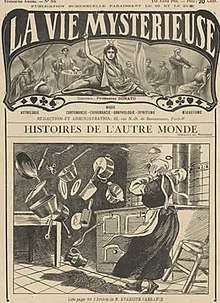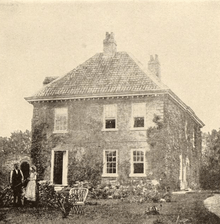Poltergeist
In ghostlore, a poltergeist (/ˈpoʊltərˌɡaɪst/ or /ˈpɒltərˌɡaɪst/; German for "noisy ghost" or "noisy spirit") is a type of ghost or spirit that is responsible for physical disturbances, such as loud noises and objects being moved or destroyed. They are purportedly capable of pinching, biting, hitting, and tripping people. Most accounts of poltergeists describe the movement or levitation of objects such as furniture and cutlery, or noises such as knocking on doors.

They have traditionally been described as troublesome spirits who haunt a particular person instead of a specific location. Such alleged poltergeist manifestations have been reported in many cultures and countries including the United States, India‚ Japan, Brazil, Australia, and most European nations. Early claims of spirits that supposedly harass and torment their victims date back to the 1st century, but references to poltergeists became more common in the early 1600s.
The overwhelming consensus of science is that poltergeists do not exist and there is generally a rational explanation for people's experiences. Misinterpretation is most likely to occur when people believe a place is haunted and they are looking for evidence to confirm this. In this way, much poltergeist activity can actually be attributed to inaccurate perception of natural phenomenon.
Etymology
The word poltergeist comes from the German language words poltern ("to make sound" and "to rumble") and Geist ("ghost" and "spirit"), and the term itself translates as "noisy ghost", "rumble-ghost" or a "loud spirit". A synonym coined by René Sudre is thorybism, from Greek thorybein ("to make noise or uproar; throw into confusion").
Suggested explanations
Natural phenomena
Many claimed poltergeist events have proved on investigation to be hoaxes.[1]
Psychical researcher Frank Podmore proposed the 'naughty little girl' theory for poltergeist cases (many of which have seemed to centre on an adolescent, usually a girl).[2] He found that the centre of the disturbance was often a child who was throwing objects around to fool or scare people for attention.[2][3] Skeptical investigator Joe Nickell says that claimed poltergeist incidents typically originate from "an individual who is motivated to cause mischief".[4] According to Nickell:
"In the typical poltergeist outbreak, small objects are hurled through the air by unseen forces, furniture is overturned, or other disturbances occur—usually just what could be accomplished by a juvenile trickster determined to plague credulous adults."
Nickell writes that reports are often exaggerated by credulous witnesses.[5]
"Time and again in other “poltergeist” outbreaks, witnesses have reported an object leaping from its resting place supposedly on its own, when it is likely that the perpetrator had secretly obtained the object sometime earlier and waited for an opportunity to fling it, even from outside the room—thus supposedly proving he or she was innocent."
According to research in anomalistic psychology, claims of poltergeist activity can be explained by psychological factors such as illusion, memory lapses, and wishful thinking.[6] A study (Lange and Houran, 1998) wrote that poltergeist experiences are delusions "resulting from the affective and cognitive dynamics of percipients' interpretation of ambiguous stimuli".[7] Psychologist Donovan Rawcliffe has written that almost all poltergeist cases that have been investigated turned out to be based on trickery, whilst the rest are attributable to psychological factors such as hallucinations.[8]
Attempts have also been made to scientifically explain poltergeist disturbances that have not been traced to fraud or psychological factors. Skeptic and magician Milbourne Christopher found that some cases of poltergeist activity can be attributed to unusual air currents, such as a 1957 case on Cape Cod where downdrafts from an uncovered chimney became strong enough to blow a mirror off of a wall, overturn chairs and knock things off shelves.[9]
Unverified natural phenomena
In the 1950s, Guy William Lambert proposed that reported poltergeist phenomena could be explained by the movement of underground water causing stress on houses.[10] He suggested that water turbulence could cause strange sounds or structural movement of the property, possibly causing the house to vibrate and move objects. Later researchers, such as Alan Gauld and Tony Cornell, tested Lambert's hypothesis by placing specific objects in different rooms and subjecting the house to strong mechanical vibrations.[10] They discovered that although the structure of the building had been damaged, only a few of the objects moved a very short distance. The skeptic Trevor H. Hall criticized the hypothesis claiming if it was true "the building would almost certainly fall into ruins."[11] According to Richard Wiseman the hypothesis has not held up to scrutiny.[10]
Michael Persinger has theorized that seismic activity could cause poltergeist phenomena.[12] However, Persinger's claims regarding the effects of environmental geomagnetic activity on paranormal experiences have not been independently replicated and, like his findings regarding the God helmet, may simply be explained by the suggestibility of participants.[13][14]
David Turner, a retired physical chemist, suggested that ball lightning might cause the "spooky movement of objects blamed on poltergeists."[15]
Paranormal
Parapsychologists Nandor Fodor and William G. Roll suggested that poltergeist activity can be explained by psychokinesis.[16][17]
Poltergeist activity has often been believed to be the work of malicious spirits by spiritualists.[18] According to Allan Kardec, the founder of Spiritism, poltergeists are manifestations of disembodied spirits of low level, belonging to the sixth class of the third order. Under this explanation, they are believed to be closely associated with the elements (fire, air, water, earth).[19]
Psychoanalyst Carl Gustav Jung was interested in the concept of poltergeists and the occult in general. Jung believed that a female cousin's trance states were responsible for a dining table splitting in two and his later discovery of a broken bread knife.[20] Jung also believed that when a bookcase gave an explosive cracking sound during a meeting with Sigmund Freud in 1909, he correctly predicted there would be a second sound, speculating that such phenomena was caused by 'exteriorization' of his subconscious mind. Freud disagreed, and concluded there was some natural cause. Freud biographers maintain the sounds were likely caused by the wood of the bookcase contracting as it dried out.[21] [22]
Famous cases
- Glenluce Devil (1654-1656)
- Drummer of Tedworth (1662)
- Mackie poltergeist (1695)
- Epworth Rectory (1716–1717)
- Hinton Ampner (1764-1771)
- Stockwell ghost (1772)
- Sampford Peverell (1810-1811)
- Bell Witch of Tennessee (1817–1872)
- Bealings Bells (1834)
- Angelique Cottin (ca. 1846)
- Ballechin House (1876)
- Great Amherst Mystery (1878–1879)
- Caledonia Mills (1899-1922)
- Gef the Talking Mongoose (1931)
- Borley Rectory (1937) [23]
- Thornton Heath poltergeist (1938)
- Seaford poltergeist (1958)
- Matthew Manning (1960s–1970s)[24]
- The Black Monk of Pontefract (1960s–1970s)
- Rosenheim Poltergeist [25][26]
- The Amityville case (1975)
- The Enfield Poltergeist (1977)
- The Thornton Road poltergeist of Birmingham (1981)
- Tina Resch (1984)
- The Canneto di Caronia fires poltergeist (2004–05)[27]
See also
- Lithobolia
- Apparitional experience
- Ghost hunting
- Mischievous fairies
- Parapsychology topics (list)
- List of topics characterized as pseudoscience
- Spiritism
- Stigmatized property
References
- Hines, Terence. (2003). Pseudoscience and the Paranormal. Prometheus Books. p. 98. ISBN 978-1573929790
- Dingwall, John; Hall, Trevor H. (1958). Four Modern Ghosts. Duckworth. pp. 13-14
- Goldstuck, Arthur. The Ghost that Closed Down the Town: The Story of the Haunting of South Africa. Penguin Books. p. 275. ISBN 978-0143025054 "Podmore advanced a 'naughty little girl' theory, suggesting that trickery accounted for nearly all poltergeist manifestations, and that the girls and boys who so often seemed to be the victims of poltergeists were actually pulling the strings."
- Joe Nickell (3 July 2012). The Science of Ghosts: Searching for Spirits of the Dead. Prometheus Books. pp. 283–. ISBN 978-1-61614-586-6.
- Nickell, Joe. "Enfield Poltergeist, Investigative Files". August 2012. Committee for Skeptical Inquiry. Retrieved 3 December 2013.
- Zusne, Leonard; Jones, Warren H. (1989). Anomalistic Psychology: A Study of Magical Thinking. Psychology Press. p. 192. ISBN 978-0805805086
- Lange, R; Houran, J. (1998). Delusions of the paranormal: A haunting question of perception. Journal of Nervous and Mental Disease 186 (10): 637–645.
- Rawcliffe, Donovan. (1988). Occult and Supernatural Phenomena. Dover Publications. pp. 377-378. ISBN 0-486-25551-4
- Christopher, Milbourne (1970). ESP, Seers & Psychics: What the Occult Really Is. New York: Crowell. p. 142. ISBN 978-0-690-26815-7. OCLC 97063.
A heavy mirror fell from the bedroom wall and an ash tray that had been resting on a table with a glass top slammed against the surface with such force that the glass was shattered.
- Wiseman, Richard (1 April 2011). Paranormality: Why We see What Isn't There. Macmillan. pp. 167–169. ISBN 978-1743038383.
- Lambert, G. W. (1955). Poltergeists: A Physical Theory. Journal of the Society for Psychical Research 38: 49-71.
- Dingwall, Eric; Hall, Trevor H. (1958). Four Modern Ghosts. Gerald Duckworth. p. 105
- Houran, James (2004). From Shaman to Scientist: Essays on Humanity's Search for Spirits. Lanham: Scarecrow Press. p. 11. ISBN 0-8108-5054-0.
- French, CC., Haque, U., Bunton-Stasyshyn, R., Davis, R. (2009), "The "Haunt" project: An attempt to build a "haunted" room by manipulating complex electromagnetic fields and infrasound" (PDF), Cortex, 45 (5): 619–629, doi:10.1016/j.cortex.2007.10.011, PMID 18635163CS1 maint: multiple names: authors list (link)
- Wiseman, Richard. "The Haunted Brain". Csicop.org. Retrieved 7 January 2019.
- Muir, Hazel (2001-12-20). "Ball lightning scientists remain in the dark". New Scientist. Retrieved 2011-01-15.
- Fodor, N. (1964). Between Two Worlds. West Nyack, NY: Parker Publishing.
- Houran, James; Lange, Rense. (2007). Hauntings and Poltergeists: Multidisciplinary Perspectives. McFarland. p. 290. ISBN 978-0786432493
- Goss, Michael. (1979). Poltergeists: An Annotated Bibliography of Works in English, Circa 1880-1975. Scarecrow Press. p. 92. ISBN 978-0810811812
- Allan Kardec, Le Livre des Esprits. (2000). chapter 106, Jean de Bonnot. p.46.
- Colin Wilson (8 November 2010). Poltergeist: A Classic Study in Destructive Hauntings. Llewellyn Worldwide. ISBN 978-0-7387-2237-5.
- Colin Wilson (21 February 2019). C.G.Jung: Lord of the Underworld. Aeon Books. pp. 2–. ISBN 978-1-912807-53-6.
- CG Jung, Memories, Dreams, Reflections, Flamingo 1983, pp 126, 179
- Harry Price, The Most Haunted House in England: Ten Years' Investigation (new edition, 1990)
- Nickell, Joe. (2015). "Poltergeist Scribbler: The Bizarre Case of Matthew Manning". Skeptical Inquirer. Retrieved 30 April 2016.
- Spraggett, Allen (Jan 2, 1974). "Pursuing the Elusive Poltergeist". The Pittsburgh Press. Retrieved 4 December 2013.
- Fairley, John; Welfare, Simon (1984). Arthur C. Clarke's World of Strange Powers. London: Harper Collins. pp. 28–31. ISBN 0-00-216679-8.
- "WorldWide Religious News-Devil in the detail of Sicily's mysterious village fires". Wwrn.org. 2004-02-11. Archived from the original on 2008-06-08. Retrieved 2009-08-19.
- Radford, Benjamin (July 17, 2013). "Poltergeists: Noisy Spirits". Live Science.
Further reading
- Christopher, Milbourne (1970). ESP, Seers & Psychics. Thomas Y. Crowell Co. ISBN 978-0-690-26815-7
- Nickell, Joe (2012). The Science of Ghosts: Searching for Spirits of the Dead. Prometheus Books. ISBN 978-1-61614-586-6
- Podmore, Frank (1896). Poltergeists. Proceedings of the Society for Psychical Research 12: 45-115.
- Goss, Michael. (1979). Poltergeists: An Annotated Bibliography of Works in English, Circa 1880-1975. Scarecrow Press.
- Price, Harry (1993). Poltergeist: Tales of the Supernatural. London: Bracken Books. ISBN 1-85891-084-6.
- Sitwell, Sacheverell. (1988, originally published in 1940). Poltergeists: An Introduction and Examination Followed by Chosen Instances. Dorset Press.
External links
| Look up poltergeist in Wiktionary, the free dictionary. |
| Wikisource has the text of the 1911 Encyclopædia Britannica article Poltergeist. |
